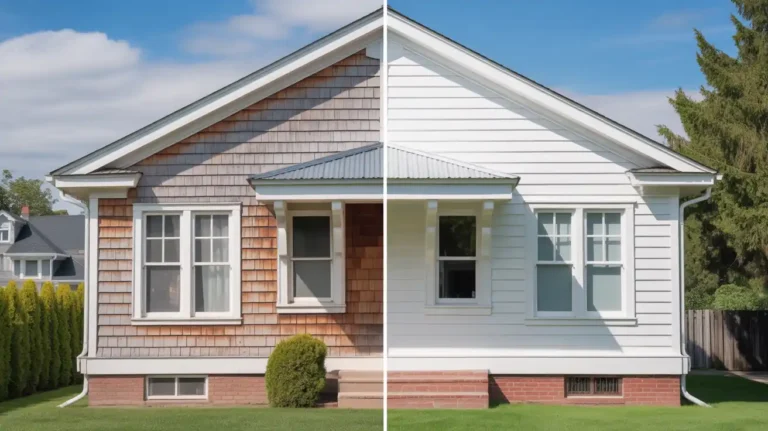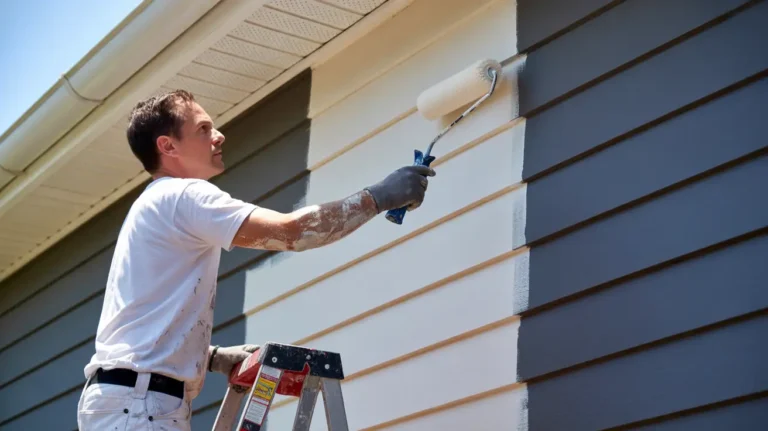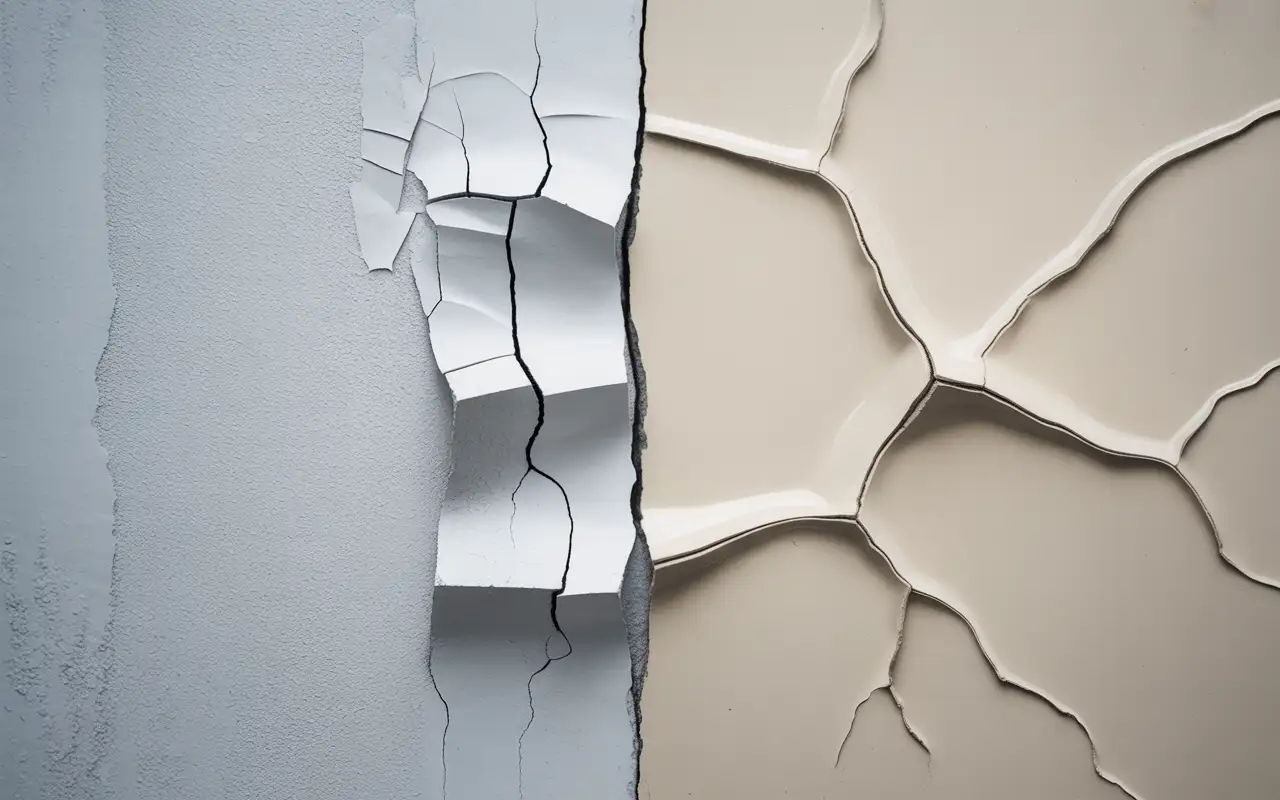Painting your home’s exterior is the fastest way to boost curb appeal and protect your investment. When dealing with fiber cement siding toughness, understanding the right process is essential for a professional finish that lasts. This guide provides the detailed steps and expert product knowledge you need to complete the job.
We will show you exactly how to paint cement board siding. We will coversiding. We will cover the crucial preparation, the necessary tools, and the specific paint chemistry that ensures your home looks fantastic for decades. By following this process, your home will be protected and its value will be refreshed.
Table of Contents
ToggleCan You Paint Fiber Cement Siding?
Yes, absolutely. Fiber cement siding, including popular brands like Hardie board, is designed to be painted. In fact, most of this material is sold either pre-primed (requiring only a topcoat) or completely bare (requiring primer and paint). Over time, a quality paint job will fade, chalk, or peel, making a fresh coat necessary.
The key to a long-lasting finish is using the correct materials and preparation techniques. Cement board is extremely durable and moisture-resistant, but its unique composition demands certain kinds of coatings to prevent chemical reactions that can ruin the paint.
Why the Right Paint Matters: Avoiding the Alkaline Problem
You cannot use just any exterior house paint on cement board. This is the single biggest difference between painting wood and painting cement siding.
The Danger of Saponification
Cement siding contains lime, which makes the material highly alkaline, or high pH. If you apply an oil-based paint directly to this surface, a chemical reaction called saponification occurs. This process breaks down the oil in the paint, essentially turning it into soap. The result is a paint film that quickly softens, peels, and develops a chalky film, completely destroying the finish.
The Rule: Oil-based paint is a hard no for cement-based products.
The Solution: 100% Acrylic Latex and pH-Blocking Primer
To prevent alkaline burn and ensure proper adhesion, you must use a 100% acrylic latex exterior paint. These are water-based and chemically stable when applied over alkaline surfaces.
For bare or unpainted cement boards, the use of a pH-blocking primer (also known as a masonry primer) is critical. This specialized primer acts as a shield between the alkaline siding and your topcoat, ensuring a strong, stable bond. If you are repainting previously painted siding that is in good shape, a simple acrylic primer on any bare spots may be sufficient.

What You'll Need for Painting Cement Board Siding
Gathering the right tools and materials before you start saves time and prevents frustration. Here’s what you’ll need:
Safety Equipment:
- Safety glasses to protect your eyes
- Dust mask or respirator
- Work gloves
- Sturdy ladder with stabilizer bars
Cleaning Supplies:
- Pressure washer (1,500 to 2,500 PSI)
- Trisodium phosphate (TSP) or specialized siding cleaner
- Soft-bristled brush for stubborn stains
- Garden hose
Repair Materials:
- High-quality exterior filler or caulk
- Putty knife
- Sandpaper (120-grit and 220-grit)
Painting Tools:
- pH-blocking primer for masonry surfaces
- 100% acrylic exterior paint
- Paint sprayer, roller, or brush (or combination)
- Paint trays and liners
- Drop cloths
- Painter’s tape
Cost Breakdown:
For a typical 2,000 square foot home, expect to spend between $800 and $1,500 for a DIY project. Here’s the breakdown:
- Premium acrylic paint (5 gallons): $250 to $400
- Primer (3 gallons): $120 to $180
- Tools and supplies: $150 to $250
- Pressure washer rental (if needed): $75 to $100 per day
- Repair materials: $50 to $100
Professional painting costs range from $3,500 to $7,000 for the same project. You’ll save $2,000 to $5,500 by doing it yourself.
Top Recommended Paints for Fiber Cement Homes
Choosing the best paint for fiber cement siding makes the difference between a paint job that lasts two years and one that lasts twenty. Here are proven options:
- Sherwin-Williams Duration Exterior: This 100% acrylic formula offers excellent coverage and weather resistance. It contains advanced polymers that flex with temperature changes. Cost: $65 to $75 per gallon. Covers 250 to 400 square feet per gallon.
- Benjamin Moore Aura Exterior: Known for superior color retention and fade resistance. The paint creates a breathable barrier that prevents moisture buildup. Cost: $70 to $85 per gallon. Provides excellent hiding power for color changes.
- Behr Premium Plus Ultra Exterior: A budget-friendly option that still delivers quality results. The formula includes mildew resistance, crucial for humid climates. Cost: $40 to $50 per gallon. Good for light refreshes and similar color applications.
Recommended Primers:
- Benjamin Moore Fresh Start Primer: Specifically designed for high-alkalinity surfaces. Blocks pH issues and creates excellent adhesion. Cost: $45 to $55 per gallon.
- Sherwin-Williams Loxon Conditioner: Professional-grade primer that stabilizes fiber cement surfaces. Reduces the number of topcoats needed. Cost: $50 to $60 per gallon.
When selecting hardie board paint recommendations, look for products labeled “for masonry” or “high-pH surfaces.” These formulations contain special binders that resist alkaline burn.
How to Paint Cement Board Siding: Step-by-Step Guide

Follow these steps for a professional-quality finish that lasts.
Step 1: Choose the Right Time
Paint when temperatures stay between 50°F and 85°F. Avoid painting in direct sunlight or when rain is forecast within 24 hours. Spring and fall offer ideal conditions in most climates. High heat causes paint to dry too quickly, creating lap marks. Cold temperatures prevent proper curing.
Step 2: Clean the Siding Thoroughly
Start with a power wash at 1,500 PSI. Hold the nozzle 12 to 18 inches from the surface at a 45-degree angle. Work from top to bottom to prevent water from getting behind the siding.
Mix TSP with warm water following package directions (typically one cup per gallon). Scrub stubborn areas with a soft-bristled brush. Pay extra attention to areas under eaves where dirt accumulates.
For mildew stains, use a solution of one part bleach to three parts water. Let it sit for 10 minutes, then rinse completely. Allow the siding to dry for 48 hours before moving forward. Moisture trapped under paint causes adhesion failure.
Step 3: Inspect and Repair Damage
Walk around your home looking for cracks, gaps, and holes. Check corners, around windows, and where pipes penetrate the siding.
Fill small cracks with exterior-grade caulk. For larger gaps, use exterior filler. Apply with a putty knife, overfilling slightly. Let it cure according to manufacturer instructions, usually 4 to 6 hours.
Sand repairs smooth with 120-grit sandpaper, then finish with 220-grit. Wipe away dust with a damp cloth. Check for loose nails and re-secure any that have popped out.
Step 4: Protect Surrounding Areas
Cover windows, doors, and trim with painter’s tape and plastic sheeting. Lay drop cloths on the ground and over plants near the house. Remove light fixtures, house numbers, and other hardware when possible.
Step 5: Apply Primer for Fiber Cement Siding
This step is non-negotiable. Even if you’re painting over existing paint, a pH-blocking primer prevents future problems.
Pour primer into your sprayer or paint tray. Start at the top corner and work in 4-foot sections. Use a brush to cut in around windows and trim first, then fill in with a roller or sprayer.
Apply primer in thin, even coats. Don’t overload the surface, which causes drips. Pay special attention to repaired areas, edges, and corners. Let the primer dry completely, typically 4 to 6 hours in good conditions.
Step 6: Apply the First Coat
Once the primer dries, apply your topcoat using the same technique. Work systematically across the wall to maintain a wet edge. This prevents visible lap marks where sections overlap.
For spray application, use a consistent distance and speed. Overlap each pass by 50%. For roller application, use a 3/8-inch nap roller designed for rough surfaces. Back-brush after rolling to work paint into the texture.
One gallon of paint typically covers 250 to 400 square feet, depending on the siding’s texture and porosity. Rough textures require more paint.
Step 7: Apply the Second Coat
Wait the recommended time between coats, usually 4 to 6 hours. Check that the first coat feels dry to the touch before starting.
The second coat provides full coverage and maximum protection. It’s especially important when making dramatic color changes. Some situations require a third coat, particularly when going from dark to light colors.
Step 8: Clean Up and Inspect
Remove painter’s tape before the paint fully cures to prevent pulling up dried paint. Clean brushes and rollers immediately with soap and water for water-based paints.
Dispose of leftover paint properly. Many communities have hazardous waste collection days. Never pour paint down drains.
Walk around your home inspecting your work. Look for missed spots, drips, or thin areas. Touch up as needed while the paint is still fresh.
Common Mistakes to Avoid
Learning from others’ errors saves you time and money.
- Skipping Surface Prep: This is the number one cause of paint failure. Dirt and mildew prevent adhesion. Take the time to clean properly.
- Painting in Wrong Weather: High humidity extends drying time. Direct sun causes blistering. Check your five-day forecast before starting.
- Using Cheap Paint: Low-quality paint requires more coats and fails sooner. The best paint for a hardie board costs more upfront but lasts longer, saving money over time.
- Not Using Primer: Primer isn’t optional on fiber cement. The alkaline surface needs this protective barrier.
- Applying Thick Coats: Thick coats look good initially but crack and peel faster. Multiple thin coats outlast one heavy application.
Maintenance Tips for Painted Fiber Cement Siding
Proper care extends the life of your paint job and keeps your home looking fresh.
- Annual Cleaning: Wash your siding once a year with a garden hose and mild detergent. This removes dirt, pollen, and environmental pollutants that degrade paint over time. Avoid pressure washing painted surfaces, as high pressure damages the coating.
- Inspect Regularly: Check your siding twice yearly for cracks, chips, or peeling. Catch problems early and touch them up before they spread. Keep a small amount of your original paint for repairs.
- Trim Vegetation: Keep bushes and trees at least 12 inches away from your siding. Plant contact traps moisture and scratches the paint surface. Overhanging branches drop debris and block airflow.
- Address Mildew Quickly: If you spot dark stains, clean them immediately with a mildew-removing cleaner. Mildew eats into paint coatings and spreads rapidly in humid conditions.
- Plan for Repainting: Quality paint on fiber cement lasts 15 to 20 years with proper care. Start planning your next project when you notice widespread fading or chalking. Don’t wait until paint fails completely, which allows moisture to damage the siding itself.
Conclusion
Painting fiber cement siding transforms your home’s appearance while protecting your investment. This project takes planning, patience, and the right materials, but the results are worth the effort. You now have the knowledge to tackle fiber cement siding painting with confidence.
Remember the key points: use only water-based acrylic paints, never skip the primer, and prepare surfaces thoroughly. These three rules prevent most paint failures.
If you’re in the San Diego area and prefer professional results, San Diego Custom Painting offers expert exterior painting services in San Diego. Our team specializes in fiber cement and hardie board applications. We also provide interior painting for complete home transformations. Whether you choose DIY or professional help, proper technique ensures lasting beauty and protection.
FAQs About Painting Cement Board Siding
What is the best paint for Hardie board siding?
The best paint for Hardie board is a high-quality, 100% acrylic latex exterior paint. These are flexible, water-based, and specifically designed to bond to the fiber cement surface, resisting cracking, peeling, and fading. Brands like Sherwin-Williams and Benjamin Moore offer excellent product lines suitable for this material.
How often should I repaint fiber cement siding?
A professional paint job using high-quality materials should last you 15 to 20 years. Factors like local climate, UV exposure, and the quality of the initial prep work can influence this lifespan.
Do I need to prime the Hardie board before painting?
It depends. Most new Hardie boards come pre-primed from the factory, meaning you only need to apply the two topcoats. If the siding is bare, unpainted, or you have sanded down to the raw cement, you must first use a pH-blocking primer to prevent alkaline burn and ensure paint adhesion.
Can I use a paint and primer in one product?
While some of these products are rated for exterior use, it is a riskier choice for bare cement boards. For the best durability and to avoid saponification, experts recommend using a dedicated, specialized pH-blocking primer for fiber cement siding first, followed by two separate coats of 100% acrylic latex paint.





